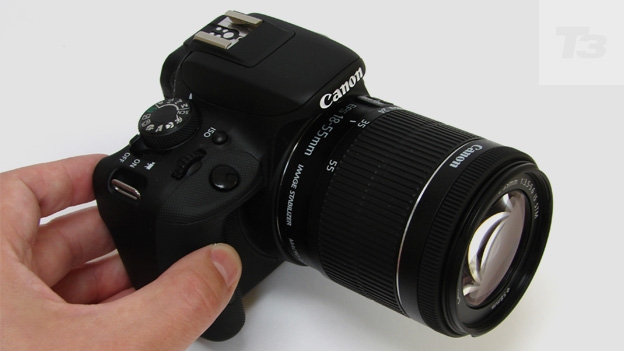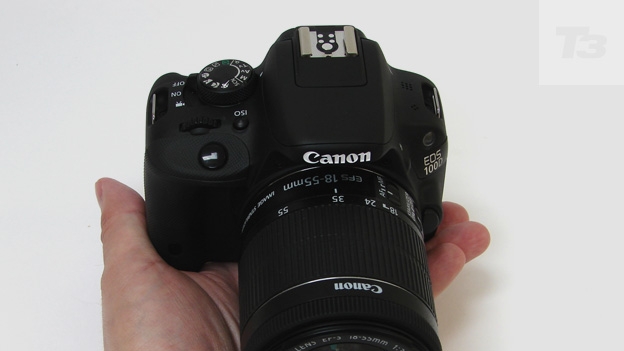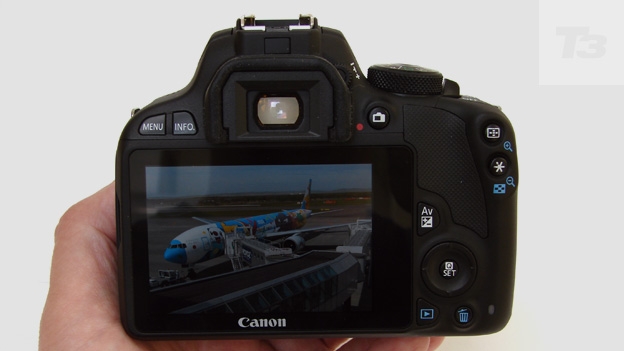Canon EOS 100D review
The Canon EOS 100D is the smallest, lightest DSLR around


-
+
Compact body
-
+
Lightweight
-
+
Good image quality
-
-
No tilting LCD
-
-
Indoors shots can be soft
-
-
Not much cheaper than 700D
Why you can trust T3







The entry-level Canon EOS 100D is the world's smallest DSLR, comparable to compact system cameras for size. But has compactness meant compromise?
For the past four years, manufacturers have strongly pitched compact system cameras (CSCs) as the next best thing to a chunky digital SLR for any of us wanting better pictures than smartphones or compact cameras were capable of.
It now appears, however, that DSLRs designed around old 35mm film camera bodies can also be compact too if they really try.
Lack of size is what the Canon EOS 100D is being sold on. At the time of writing it's claimed to be the 'world's smallest and lightest' DSLR, measuring an official 116.8x90.7x69.4mm and weighing 407g. Its pint-sized dimensions mean that it's similar in size to a CSC, like the Panasonic GH3.
It manages this feat while retaining a conventional DSLR design, an aluminium and resin construction, plus the 18 megapixel APS-C sized sensor also utilised by the larger Canon EOS 700D that sits at the top of its maker's consumer DSLR range.
Most notably, the desire to make the Canon 100D as compact as possible has meant the omission of the angle adjustable LCD found on the Canon 700D, plus a rather foreshortened handgrip in comparison that may dissuade those with larger hands.
However a roughened surface to the grip that's also moulded to provide spaces for fingers helps, as does the relatively lightweight feel.
This ensured that even with bundled 18-55mm standard zoom attached, we never felt concerned about dropping the 100D, even when shooting with one hand. It also enabled us to cart the DSLR around for most of a day without inducing neck or shoulder ache.
While the 100D's specification and operation is otherwise very similar to the more expensive 700D, and we get the same Digic 5 image processor, here continuous shooting speed is limited to a 'mere' 4 frames per second rather than 5fps to further differentiate the two.
More positively, and something well worth mentioning if you're considering the 100D as your first Canon DSLR is that, bundled kit zoom aside, this camera is further compatible with 75 additional lenses from its maker.
There are also third party optics, so you'll never be lacking in creative choice, aside from the camera's built-in Creative Auto mode, which allows for more vivid colour or black and white imagery at the point of camera.
The price for the above is a manufacturer's suggested £709.99 with lens, or £579.99 without, which surprisingly makes it just £50 less than the flagship EOS 700D. That camera has the adjustable screen, better grip and faster frame rate. So is small truly beautiful when it comes to the 100D?
Get all the latest news, reviews, deals and buying guides on gorgeous tech, home and active products from the T3 experts
Canon EOS 100D: Controls
Aside from the smaller handgrip and fixed screen at the rear, it's pretty much DSLR business as usual when it comes to the 100D's control layout; with the caveat that it feels like nothing extraneous or fussy has been included.
We still get a nicely chunky and stiff feel shooting mode dial with 12 settings, which is ergonomically encircled by an on/off lever that also provides a third setting for the Full HD video mode; as this option isn't included on the actual dial.
This means that, in practice, a simple flick of the lever will activate the video facility and switch the rear plate LCD to Live View mode, regardless of whichever stills shooting mode has been selected.
A dedicated button for summoning up ISO speeds just behind the shutter release button is a helpful touch for those interested in shooting in natural light only, while dedicated delete, playback, menu and info buttons further the user friendliness – despite their tiny size requiring fingertip operation.
In short, while those who are used to a DSLR will be able to pick the 100D up and start shooting straight away, users of compact point and shoot snappers or smartphones like the iPhone 5 or HTC One, shouldn't take too long to find their way around it either.
Canon EOS 100D: Screen
The 3-inch, impressively high 1040K-dot resolution LCD screen is a touch screen. This meant that we were able to scroll through images in playback mode with a swipe of a finger, as well as enlarge portions to check the focus with a simple flick of forefinger and thumb, which makes for intuitive operation.
If you prefer using the hard key backplate buttons and a regular command pad too, you can, so there's also something here for the traditionalists.
Activate Live View mode and the 100D's screen can be used for composition as well as review, which is the default setting anyway if in video capture mode. Furthermore, the LCD offers a 100% field of view, so what we see on screen is what we get in the resultant shot.
This means it's an able alternative to the smaller optical viewfinder for those who don't always shoot with the camera held at eye level, and useful if you want a larger display to check a sharp focus has been achieved whether shooting manually or utilising the camera's mostly reliable auto focus.
Canon EOS 100D: Battery
While the 100D's LP-E12 rechargeable lithium ion battery performance isn't quite as grand as that of its bigger brother the 700D at 440 shots, the 100D offers up a maximum 380 pictures if operating at room temperature. We were away with the camera for two weeks, using it more or less every day but only had to recharge it twice, with a separate mains charger provided for the purpose.
This means there's the ability to free up the camera if you purchase a spare battery, so that it's never out of action. While the power performance isn't up there with professional models, it's more than sufficient for keen amateurs.
Canon EOS 100D: Picture quality
Though the smaller and lighter physical proportions of the 100D introduce the occasional soft shot due to camera shake if shooting handheld with the 18-55mm kit zoom in low light, this can usually be solved by bumping up the ISO setting to say ISO1600 to achieve clarity yet avoid grain, while the lens also comes with a stabilizer that can be flicked on or off, in lieu of anti shake being built into the body.
In brighter daylight conditions the 100D excels, the 18 megapixel sensor and lens combination capturing plenty of detail that results in images which clearly look a cut above what could be achieved with a humble fixed lens compact. Yes, there is the occasional loss of highlight detail in strong sun, but as we say this is only occasionally the case.
We didn't try the camera with physically bigger lenses with longer focal lengths however, which we can see that this might make its use impractical for some, as it would introduce a front heavy look and feel. But with the consumer-targeted kit zoom or a 40mm pancake lens attached, the 100D comes into its own as an everyday tool.
The auto focus is impressively swift to respond when shooting video as well as stills. As we noted in our section on controls, first flick the top plate lever to the video mode setting, at which point the rear LCD bursts into life to aid framing and, if choosing to operate the focus manually, this display also allows the user to achieve a sharp image.
Commencing or ending recording involves pressing a record button on the backplate, while a half squeeze of the shutter release button automatically alters focus for you. In a nutshell the 100D is one of the most straightforward DSLRs when it comes to shooting video.
Canon EOS 100D: Verdict
The compact proportions of the 18 megapixel Canon EOS 100D and its relatively lightweight feel make it an ideal holiday camera, for when you want that DSLR quality, while the smaller size also makes it less intimidating for human subjects, resulting in shots that feel less 'forced'.
OK, it's still not quite as small as the likes of the brand's own compact Canon EOS M (again with APS-C sensor) if you truly want a camera with close to DSLR quality but none of the bulk. But, if you're considering your first ever DSLR, the Canon EOS 100D is an ideal place to start.
Canon EOS 100D release date: Out now
Canon EOS 100D price: £579.99 (body only), £749.99 (with 18-55mm standard zoom kit lens)

Gavin Stoker has been writing about photography and technology for the past 20 years. He currently edits the trade magazine British Photographic Industry News - BPI News for short - which is a member of TIPA, the international Technical Imaging Press Association.